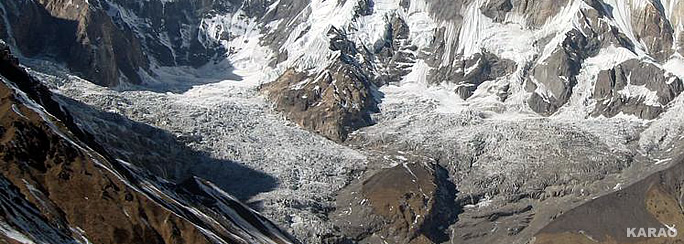 |
Nepal Himalayas Glaciers |
|
 |
Nepal Information |
|
|
 |
|
Nepal:
Climate change is real and happening now
|

|
 |
|
Climate
change in the Himalayas: Increased hazards and reduced water security
|
 |
The
International Centre for Integrated Mountain Development (ICIMOD) and the
World Agroforesty Center , China (ICRAF-China) alert the global community
to the impacts of climate change on the Himalayan water resources.
Global
climate change is causing rapid melting of snow and glaciers in the Himalayan
region. The Greater Himalaya has the largest
concentration snow and Ice outside the two poles. Water from the Himalayan
river systems flows into water basins with a total population of almost
1.3 billion. Warming in the Himalayan region has been much greater than
global average. Both increasing and decreasing rain fall patters have
been detected in the area. Weather patterns are becoming more unpredictable
and extreme - dry seasons become dryer and wet seasons wetter. This phenomenon
is causing concern over the long term reduction in total water supply,
affecting lives and livelihoods of the Himalayan people, especially in
agriculture practices and long term food security.
Ten
large river systems originate from the high Himalayan mountains. The
river basins of these systems provide water for 1.3 billion people in the
basins, and around 200 million people in the upstream. The developed
world produces green house gases in far bigger quantity than the Himalayan
countries. Yet the people in the Himalayan
region are paying the price of climate change in the form of extreme weather
events such as flash floods, glacial lake outburst floods, high intensity
rain fall and extreme drought.
Strengthening
the resilience of the mountain population, without jeopardizing economic
growth, means that substantial efforts will have to be made in adaptation.
This means large investments, and also long term institutional cooperation.
Says
Dr. Andreas Schild, Director General of ICIMOD, "The signs of global climate
change are visible, but the in-depth knowledge and data from the Himalayan
region is largely missing. There is an urgent need to increase scientific
co-operation and regional collaboration to reduce this information gap."
For the policy orientation the following lines of action should be considered:
 Increasing
the capacity to manage risk and hazards affecting the most vulnerable people. Increasing
the capacity to manage risk and hazards affecting the most vulnerable people.
 Increasing
the regional and transboundary cooperation to improve early warning systems. Increasing
the regional and transboundary cooperation to improve early warning systems.
 Promoting
integrated river basin and water management schemes. Promoting
integrated river basin and water management schemes.
 Strengthening
policies which enable the storage of surplus water during the monsoon,
and improving the availability of water during dry season (watershed development,
afforestation, infrastructure for water storage and hydro electricity). Strengthening
policies which enable the storage of surplus water during the monsoon,
and improving the availability of water during dry season (watershed development,
afforestation, infrastructure for water storage and hydro electricity).
 Promoting
the exchange of scientific data thus reducing uncertainty, and clarifying
the relation between economic growth, pollution and the receding cryosphere
in the Himalayas. Promoting
the exchange of scientific data thus reducing uncertainty, and clarifying
the relation between economic growth, pollution and the receding cryosphere
in the Himalayas.
 |
Gokyo (4790 m)
| The
Hindu Kush-Himalayan region is the highest, most complex mountain region
in the world.
It
extends more than 3500km over eight countries, from Afghanistan in the
north-west to Myanmar in the south-east. The region ranges from the plateau
regions of Tibet and other mountain areas of China, to the Ganges Basin
in India, and has the upland watersheds of the ten major Asian river systems. |
|
 |
| Source:
ICIMOD, International Centre for Integrated Mountain Development , 19 Nov
2008 |
ICIMOD
The
International Centre for Integrated Mountain Development (ICIMOD) is an
independent 'Mountain Learning and Knowledge Centre' serving the eight
member countries of the Hindu-Kush-Himalayas - Afghanistan, Bangladesh,
Bhutan, China, India, Myanmar, Nepal and Pakistan - and the global mountain
community. ICIMOD is a non-political intergovernmental organisation which,
since 1983, has encouraged technical cooperation between governments in
the region and whose primary objective is to help promote the development
of environmentally sound mountain ecosystems and improve the living standards
of the mountain population. www.icimod.org

|
|
Glaciers
flowing down from Annapurna I
|
top
|
more information
|

|
| Snow, Ice, Glaciers, Glacial Lakes and Floods - Reports |
 |
| Himalayas |
 |
Snow, Ice, Glacier, Glacial Lakes and Floods Reports |
 |
|
Links |

|
 |
 |
External
link |
 |
International
Centre for Integrated Mountain Development
ICIMOD |
|
 |
|



![]() Increasing
the capacity to manage risk and hazards affecting the most vulnerable people.
Increasing
the capacity to manage risk and hazards affecting the most vulnerable people.
![]() Increasing
the regional and transboundary cooperation to improve early warning systems.
Increasing
the regional and transboundary cooperation to improve early warning systems.
![]() Promoting
integrated river basin and water management schemes.
Promoting
integrated river basin and water management schemes.
![]() Strengthening
policies which enable the storage of surplus water during the monsoon,
and improving the availability of water during dry season (watershed development,
afforestation, infrastructure for water storage and hydro electricity).
Strengthening
policies which enable the storage of surplus water during the monsoon,
and improving the availability of water during dry season (watershed development,
afforestation, infrastructure for water storage and hydro electricity).
![]() Promoting
the exchange of scientific data thus reducing uncertainty, and clarifying
the relation between economic growth, pollution and the receding cryosphere
in the Himalayas.
Promoting
the exchange of scientific data thus reducing uncertainty, and clarifying
the relation between economic growth, pollution and the receding cryosphere
in the Himalayas.


